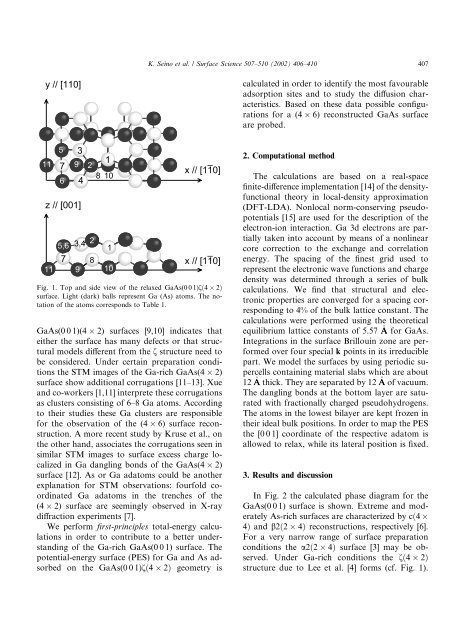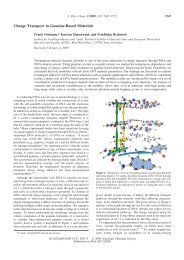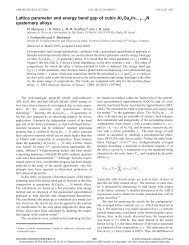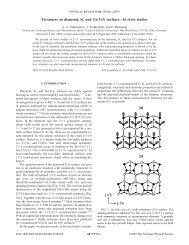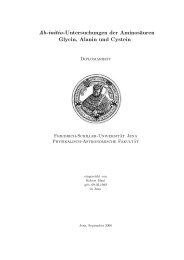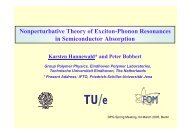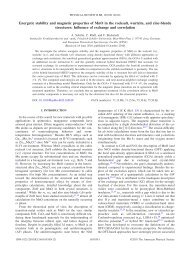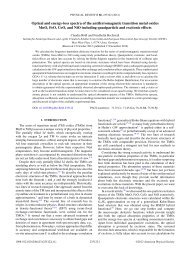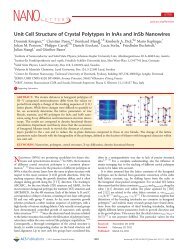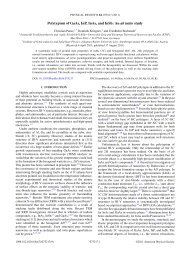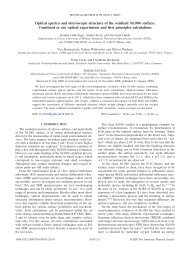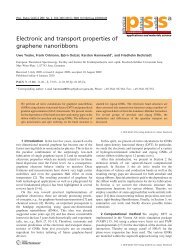Structure and energetics of Ga-rich GaAs(001) surfaces - Institut für ...
Structure and energetics of Ga-rich GaAs(001) surfaces - Institut für ...
Structure and energetics of Ga-rich GaAs(001) surfaces - Institut für ...
Create successful ePaper yourself
Turn your PDF publications into a flip-book with our unique Google optimized e-Paper software.
K. Seino et al. / Surface Science 507–510 (2002) 406–410 407<br />
calculated in order to identify the most favourable<br />
adsorption sites <strong>and</strong> to study the diffusion characteristics.<br />
Based on these data possible configurations<br />
for a (4 6) reconstructed <strong>Ga</strong>As surface<br />
are probed.<br />
2. Computational method<br />
Fig. 1. Top <strong>and</strong> side view <strong>of</strong> the relaxed <strong>Ga</strong>As(0 0 1)fð4 2Þ<br />
surface. Light (dark) balls represent <strong>Ga</strong> (As) atoms. The notation<br />
<strong>of</strong> the atoms corresponds to Table 1.<br />
<strong>Ga</strong>As(0 0 1)(4 2) <strong>surfaces</strong> [9,10] indicates that<br />
either the surface has many defects or that structuralmodels<br />
different from the f structure need to<br />
be considered. Under certain preparation conditions<br />
the STM images <strong>of</strong> the <strong>Ga</strong>-<strong>rich</strong> <strong>Ga</strong>As(4 2)<br />
surface show additionalcorrugations [11–13]. Xue<br />
<strong>and</strong> co-workers [1,11] interprete these corrugations<br />
as clusters consisting <strong>of</strong> 6–8 <strong>Ga</strong> atoms. According<br />
to their studies these <strong>Ga</strong> clusters are responsible<br />
for the observation <strong>of</strong> the (4 6) surface reconstruction.<br />
A more recent study by Kruse et al., on<br />
the other h<strong>and</strong>, associates the corrugations seen in<br />
similar STM images to surface excess charge localized<br />
in <strong>Ga</strong> dangling bonds <strong>of</strong> the <strong>Ga</strong>As(4 2)<br />
surface [12]. As or <strong>Ga</strong> adatoms could be another<br />
explanation for STM observations: fourfold coordinated<br />
<strong>Ga</strong> adatoms in the trenches <strong>of</strong> the<br />
(4 2) surface are seemingly observed in X-ray<br />
diffraction experiments [7].<br />
We perform first-principles total-energy calculations<br />
in order to contribute to a better underst<strong>and</strong>ing<br />
<strong>of</strong> the <strong>Ga</strong>-<strong>rich</strong> <strong>Ga</strong>As(0 0 1) surface. The<br />
potential-energy surface (PES) for <strong>Ga</strong> <strong>and</strong> As adsorbed<br />
on the <strong>Ga</strong>As(0 0 1)fð4 2Þ geometry is<br />
The calculations are based on a real-space<br />
finite-difference implementation [14] <strong>of</strong> the densityfunctionaltheory<br />
in local-density approximation<br />
(DFT-LDA). Nonlocal norm-conserving pseudopotentials<br />
[15] are used for the description <strong>of</strong> the<br />
electron-ion interaction. <strong>Ga</strong> 3d electrons are partially<br />
taken into account by means <strong>of</strong> a nonlinear<br />
core correction to the exchange <strong>and</strong> correlation<br />
energy. The spacing <strong>of</strong> the finest grid used to<br />
represent the electronic wave functions <strong>and</strong> charge<br />
density was determined through a series <strong>of</strong> bulk<br />
calculations. We find that structural <strong>and</strong> electronic<br />
properties are converged for a spacing corresponding<br />
to 4% <strong>of</strong> the bulk lattice constant. The<br />
calculations were performed using the theoretical<br />
equilibrium lattice constants <strong>of</strong> 5.57 A for <strong>Ga</strong>As.<br />
Integrations in the surface Brillouin zone are performed<br />
over four special k points in its irreducible<br />
part. We modelthe <strong>surfaces</strong> by using periodic supercells<br />
containing material slabs which are about<br />
12 A thick. They are separated by 12 A <strong>of</strong> vacuum.<br />
The dangling bonds at the bottom layer are saturated<br />
with fractionally charged pseudohydrogens.<br />
The atoms in the lowest bilayer are kept frozen in<br />
their idealbulk positions. In order to map the PES<br />
the [0 0 1] coordinate <strong>of</strong> the respective adatom is<br />
allowed to relax, while its lateral position is fixed.<br />
3. Results <strong>and</strong> discussion<br />
In Fig. 2 the calculated phase diagram for the<br />
<strong>Ga</strong>As(0 0 1) surface is shown. Extreme <strong>and</strong> moderately<br />
As-<strong>rich</strong> <strong>surfaces</strong> are characterized by cð4 <br />
4Þ <strong>and</strong> b2ð2 4Þ reconstructions, respectively [6].<br />
For a very narrow range <strong>of</strong> surface preparation<br />
conditions the a2ð2 4Þ surface [3] may be observed.<br />
Under <strong>Ga</strong>-<strong>rich</strong> conditions the fð4 2Þ<br />
structure due to Lee et al. [4] forms (cf. Fig. 1).


